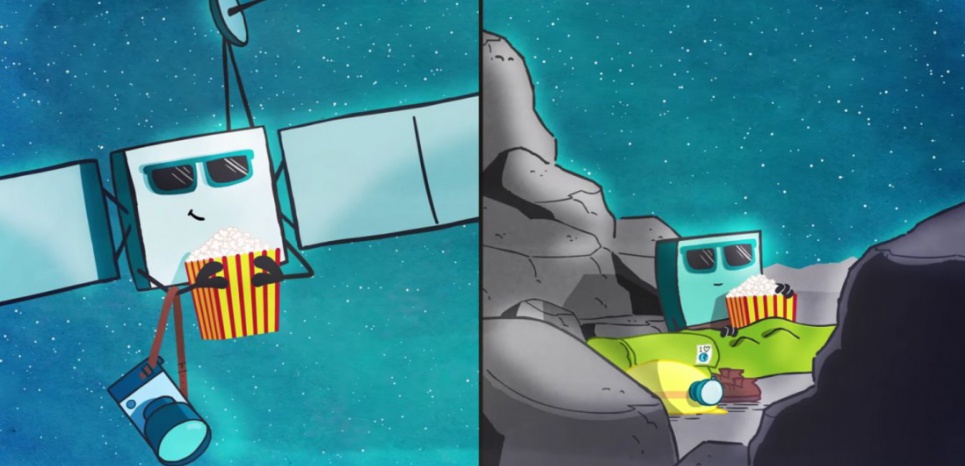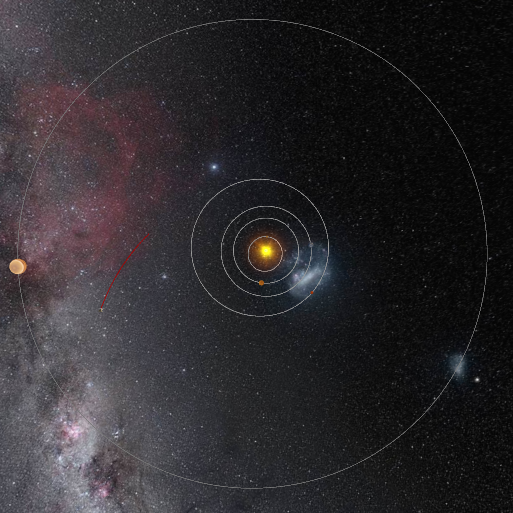Rosetta's mission: the end is near
September 30 interplanetary station will be put on the surface of the comet Churyumov-Gerasimenko

Shot from the animated film Rosetta and Philae
Last year, representatives of the Rosetta interplanetary station project team made a bold suggestion : put the device on a comet, thus completing a 12-year mission. Previously, it was planned to simply turn off the station so that the project team could take up other projects. But now Rosetta, in case of a successful landing, can continue its work for some time, studying the comet. Why should the project be closed? Because the station is constantly moving away from the Earth and the Sun. Rosetta solar panels are getting less energy, soon it will not be enough for the normal operation of the spacecraft. In addition, the thread connecting Rosetta and the Earth becomes thinner - it’s about a communication channel. The capacity of the channel all the time decreases all for the same reason - the station is removed from the Earth.
')
Rosetta spent in space for about 12 years. 2 years the station studied the comet Churyumov-Gerasimenko. At this stage, the most important task was to land a Philae probe on the surface of this object. The device sat on the comet, but everything went a little out of plan - Philae bounced off when landing , flew several hundred meters and finally stopped after the fourth jolt. At the same time, Philae was stuck in a crack, the depth of which reached several meters. Despite all these problems, the specialists managed to use the functioning scientific instruments of the probe, and the research program was completed at 80% in just 64 hours.
As part of this program, it was possible to verify the surface hardness of the comet (as it was supposed, the comet is quite loose, the main components of the surface are ice and dust). We also managed to measure the surface temperature, take a picture of it, analyze the gases and the composition of the dust. On the comet Churyumov-Gerasimenko there was a large amount of organic compounds, and quite complex ones. Among the most common are formaldehyde, methyl isocyanate, acetamide and other substances.

After 64 hours, the probe went into hibernation mode. Scientists believed that as the comet approached the Sun, the probe would receive more and more energy, which would allow it to return to work. Last June, this happened, and the unit was able to respond to Earth signals, using Rosetta as a repeater. True, communications were fragmentary. The first lasted 78 seconds, the second - already 4 minutes, the third - 19 minutes. During this time, it was possible to take the whole part of the telemetry data, due to the fact that the connection was not too good. But the fact that earth scientists have received, helped to understand what happened to the device. After that, Philae fell silent, although a month later he was still able to be contacted again. Within 17 minutes a connection was maintained with the probe, and all telemetry was loaded.
But after this, communication attempts had to be discontinued due to the fact that Rosetta had to change the trajectory of the movement - scientific research involved the study of another part of the comet. It was impossible to contact the probe from there, and Philae was silent forever.
Now it is the turn of silence for Rosetta, however much the scientists would like to extend the life of the device. The last minutes of the life of the device will not be meaningless - the station will work to the last, taking measurements of various parameters of the comet, photographing its surface in high resolution and performing other tasks. All this time will be transmitted to Earth. As Rosetta decreases, the communication channel will be available, but after the device has come down to the surface of comet Churyumov-Gerasimenko, all operations will stop.
“We will try to complete the maximum number of tasks at this time, as many times as possible until the moment when the solar energy is stopped. September 30th is the end of all operations, but „the beginning of the end“ will allow us to obtain a large amount of scientific information. That’s why Rosetta was launched into space, and we worked for several years, carefully analyzing the mission data, ”says Matt Taylor, a leading scientific expert on the Rosetta project.
The operators of the device will begin to change its trajectory in August, with access to a series of elliptical orbits, the latter of which will allow the device to come closer to the comet for a minimum distance and sit on the surface of this object. Experts argue that planning the final phase is more complicated than landing Philae. The last six weeks, during which Rosetta will perform maneuvers, are much more difficult for scientists than the landing itself. The fact is that as it comes closer to the comet Churyumov-Gerasimenko, it will have an increasing influence on the apparatus. This will require scientists to especially carefully monitor the orbit of the station, with its retention in the specified parameters.

Where will the comet be on September 30th?
It remains only to wish the scientists good luck, and the station itself to sit down so gently that after many years, possibly centuries, Rosetta could be removed from the comet and installed in any interstellar museum of the history of space exploration.

Shot from the animated film Rosetta and Philae
Last year, representatives of the Rosetta interplanetary station project team made a bold suggestion : put the device on a comet, thus completing a 12-year mission. Previously, it was planned to simply turn off the station so that the project team could take up other projects. But now Rosetta, in case of a successful landing, can continue its work for some time, studying the comet. Why should the project be closed? Because the station is constantly moving away from the Earth and the Sun. Rosetta solar panels are getting less energy, soon it will not be enough for the normal operation of the spacecraft. In addition, the thread connecting Rosetta and the Earth becomes thinner - it’s about a communication channel. The capacity of the channel all the time decreases all for the same reason - the station is removed from the Earth.
')
Rosetta spent in space for about 12 years. 2 years the station studied the comet Churyumov-Gerasimenko. At this stage, the most important task was to land a Philae probe on the surface of this object. The device sat on the comet, but everything went a little out of plan - Philae bounced off when landing , flew several hundred meters and finally stopped after the fourth jolt. At the same time, Philae was stuck in a crack, the depth of which reached several meters. Despite all these problems, the specialists managed to use the functioning scientific instruments of the probe, and the research program was completed at 80% in just 64 hours.
As part of this program, it was possible to verify the surface hardness of the comet (as it was supposed, the comet is quite loose, the main components of the surface are ice and dust). We also managed to measure the surface temperature, take a picture of it, analyze the gases and the composition of the dust. On the comet Churyumov-Gerasimenko there was a large amount of organic compounds, and quite complex ones. Among the most common are formaldehyde, methyl isocyanate, acetamide and other substances.

After 64 hours, the probe went into hibernation mode. Scientists believed that as the comet approached the Sun, the probe would receive more and more energy, which would allow it to return to work. Last June, this happened, and the unit was able to respond to Earth signals, using Rosetta as a repeater. True, communications were fragmentary. The first lasted 78 seconds, the second - already 4 minutes, the third - 19 minutes. During this time, it was possible to take the whole part of the telemetry data, due to the fact that the connection was not too good. But the fact that earth scientists have received, helped to understand what happened to the device. After that, Philae fell silent, although a month later he was still able to be contacted again. Within 17 minutes a connection was maintained with the probe, and all telemetry was loaded.
But after this, communication attempts had to be discontinued due to the fact that Rosetta had to change the trajectory of the movement - scientific research involved the study of another part of the comet. It was impossible to contact the probe from there, and Philae was silent forever.
Now it is the turn of silence for Rosetta, however much the scientists would like to extend the life of the device. The last minutes of the life of the device will not be meaningless - the station will work to the last, taking measurements of various parameters of the comet, photographing its surface in high resolution and performing other tasks. All this time will be transmitted to Earth. As Rosetta decreases, the communication channel will be available, but after the device has come down to the surface of comet Churyumov-Gerasimenko, all operations will stop.
“We will try to complete the maximum number of tasks at this time, as many times as possible until the moment when the solar energy is stopped. September 30th is the end of all operations, but „the beginning of the end“ will allow us to obtain a large amount of scientific information. That’s why Rosetta was launched into space, and we worked for several years, carefully analyzing the mission data, ”says Matt Taylor, a leading scientific expert on the Rosetta project.
The operators of the device will begin to change its trajectory in August, with access to a series of elliptical orbits, the latter of which will allow the device to come closer to the comet for a minimum distance and sit on the surface of this object. Experts argue that planning the final phase is more complicated than landing Philae. The last six weeks, during which Rosetta will perform maneuvers, are much more difficult for scientists than the landing itself. The fact is that as it comes closer to the comet Churyumov-Gerasimenko, it will have an increasing influence on the apparatus. This will require scientists to especially carefully monitor the orbit of the station, with its retention in the specified parameters.

Where will the comet be on September 30th?
It remains only to wish the scientists good luck, and the station itself to sit down so gently that after many years, possibly centuries, Rosetta could be removed from the comet and installed in any interstellar museum of the history of space exploration.
Source: https://habr.com/ru/post/395807/
All Articles